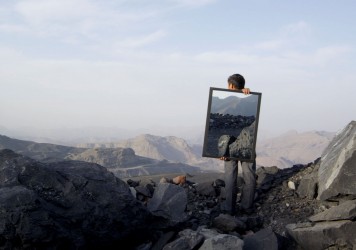China’s foremost proponent of large-scale pyrotechnics is the star of this engaging documentary from Kevin Macdonald.
Did you know that gunpowder was originally discovered by Taoist monks in the 9th century completely by chance while they were searching for an elixir of immortality? This is just one of many revelations in Sky Ladder: The Art of Cai Guo-Qiang, which profiles the titular Chinese modern artist while gauging his explosive impact on the global art scene.
Guo-Qiang lays claim to being the first artist in history to have a single artwork seen by more than one billion people, having created a firework sculpture for the 2008 Olympics which lit up the Beijing skyline during the televised opening ceremony. If that was the spectacular moment Guo-Qiang arrived on the world stage, it’s also one that best represents his internal conflict as an artist. His capacity to wow huge crowds with ingeniously choreographed “exploding events” coupled with his natural flair for showmanship has made Guo-Qiang a go-to for the Chinese government. But does the undeniable commerciality of his work necessarily undermine its artistic value?
Not according to Guo-Qiang, who is acutely aware of his somewhat delicate political position yet adamant that an environmentally and socially conscious artist like himself is well placed to change the system from within. In Western media, China is often treated like an ominous, not-too distant spectre on the horizon. This film offers some welcome insight into the country’s cultural past and present, with Guo-Qiang bridging the gap as a prominent national treasure whose distinct style was born out of the remnants of feudalism but influenced by everything from his own comparatively traditional artist father to contemporary Chinese, Japanese and even Western art.
Principally, it traces his seemingly impossible dream to build a ‘Sky Ladder’ made out of hundreds of metres of firecrackers and erected via a massive hot air balloon, a long-gestating project that, following several false starts, initially leads him back to the small fishing village where he once visited his grandmother. Despite him now residing in New York City, it’s clear from this intimate portrait that Guo-Qiang has never lost touch with his ancestral roots. This being an art doc, there’s naturally a lot of chin-strokey subtextual analysis of Guo-Qiang’s work from bespectacled art world intelligentsia types. But by far the most interesting aspect of director Kevin Macdonald’s film is Guo-Qiang himself – a brilliant and at times baffling artist who basically just really loves blowing stuff up.
Published 12 Oct 2016
A film about a man who blows things up for a living? Sold.
Flash bang wallop. A fascinating portrait of an artist’s obsession.
Steven Spielberg likes it. So do we.

The opening night film of this year’s Human Rights Watch Film Festival shows China on a collision course with chaos.

The poetry and horror of globalisation and manual labour are beautifully evoked in this haunting doc-fiction hybrid.